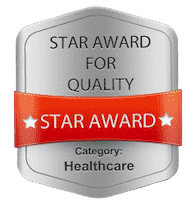Thalassemia is an inherited blood disorder that affects the production of hemoglobin. Hemoglobin is the protein in red blood cells that carries oxygen to the body’s tissues. People with thalassemia have less hemoglobin than normal and may have red blood cells that are smaller than normal. Thalassemia can lead to anemia, which means that there aren’t enough red blood cells to carry oxygen to the body’s tissues.
If left untreated, thalassemia can lead to anemia, which can cause fatigue, shortness of breath, and other health problems
Homeopathy is a safe and effective treatment for thalassemia. Our homeopathic remedies are tailored to each individual’s needs, and they have helped many people with thalassemia live healthy lives.
Best Homeopathy Treatment of Thalassemia
Yes, CUREplus Homeopathy Treatment from Welling can help in long term management of thallassemia.
The major benefit of Homeopathy treatment of Thalassemia is the patient is able to live stress-free healthier life without repeated blood transfusions and hospital visits.
Treatment of Thalassemia at Welling Homeopathy Clinics involves our specially formulated Homeopathy medicines. Welling Homeopathy CUREPlus treatment offers customized medication that can help to reduce the need for frequent blood transfusion.
Homeopathy medicines for Thalassemia also help to improve immune status, which in turn also controls frequent attacks of respiratory infections. Visit one of our clinics for more clarity on the treatment of Thalassemia Major and to know if our treatment can help you or you’re loved one.
Call +91 8080 850 950 to book an appointment or to consult and order online. Consult our specialists today for a detailed evaluation and to start your customized Homeopathy medicines for Thalassemia.

What is Thalassemia?
Thalassemia is a blood disorder passed down through families in which the body makes abnormal hemoglobin, the protein in red blood cells that carries oxygen. The disorder results in excessive destruction of red blood cells which leads to anemia.
Thalassemia is a genetic blood disease. People born with this disease cannot make normal hemoglobin which is needed to produce healthy red blood cells. Thalassemia is not infectious and cannot be passed from one individual to another by personal contact.
Thalassemia is a blood disorder that is characterized by a reduction in the number of alpha-globin chains, thereby reducing the oxygen-carrying capacity of hemoglobin.
The lack of alpha-globin chains leads to anemia and excess production of ineffective RBCs (red blood cells). People with thalassemia may have recurrent infections or other complications due to their low levels of functional hemoglobin. The severity ranges from mild cases requiring no treatment, moderate cases treated by regular transfusions, and severe cases which require bone marrow transplantation.
Thalassemia is caused by mutations of the globin genes which code for alpha, beta and gamma chains forming hemoglobin. These mutations reduce or eliminate fetal globin production leading to a lack of functional hemoglobin in the red blood cells which are formed after birth. Thalassemias are inherited in an autosomal recessive manner, which means that two copies of an abnormal gene must be present in each cell in order to result in the disease.
Symptoms of Thalassemia
The symptoms of thalassemia vary depending on the type of thalassemia.
Symptoms will not show until the age of 6 months in most infants with beta-thalassemia and some types of alpha thalassemia. This is because neonates have a different type of hemoglobin, called fetal hemoglobin.
After 6 months “normal” hemoglobin starts replacing the fetal type, and symptoms may begin to appear.
These include:
- jaundice and pale skin
- drowsiness and fatigue
- chest pain
- cold hands and feet
- shortness of breath
- leg cramps
- rapid heart beat
- poor feeding
- delayed growth
- headaches
- dizziness and faintness
- greater susceptibility to infections
Skeletal deformities may result as the body tries to produce more bone marrow.
If there is too much iron, the body will try to absorb more iron to compensate. Iron may also accumulate from blood transfusions. Excessive iron can harm the spleen, heart, and liver.
Patients with hemoglobin H are more likely to develop gallstones and an enlarged spleen.
Untreated, the complications of thalassemia can lead to organ failure.
Causes Of Thalassemia
The exact cause of thalassemia isn’t known. It may be caused by having fewer copies of genes needed to make hemoglobin. This results from mutations in either of 2 different genes called HBB1 and HBB2. These genes code for proteins found inside red blood cell precursors. Mutations in these genes prevent enough protein production so that there aren’t enough mature red blood cells.
The causes of thalassemia can be either inherited or acquired. The most common form is the Mediterranean type found mostly in people with ancestry from the Middle East, India, and Southeast Asia. This form is inherited from a person’s parents in an autosomal recessive pattern.
The second most common form is called “thalassemia major.” Thalassemia major is characterized by severe anemia. In this form, red blood cells have a reduced number of hemoglobin (Hb) chains. Hb contains two alpha chains and two beta chains. Thalassemia minor is a milder form that also results in less than optimal amounts of Hb chains.
Alpha-thalassemia
The most common form of this disease occurs when there aren’t enough copies of the alpha globin chain. This results in fewer mature red blood cell precursors being produced. As a result, patients experience chronic low levels of iron stores and may become severely anemic. Patients also tend to have lower Hgb levels because they lack sufficient amounts of functional hemoglobin protein.
Beta-thalassemia
Less commonly seen, beta-thalassemia occurs when there isn’t enough beta globin chains. The resulting decrease in hemoglobin causes less oxygen transport throughout the body. In addition, it can lead to heart failure if left untreated. Beta-thalassemias are more severe than alpha-thalassemia as their effects on the bone marrow are much greater.
Risks for Thalassemia
The risk of having a baby with thalassemia increases as the mother gets older. Women over 35 when they become pregnant are about twice as likely to give birth to babies with thalassemia than women younger than 25.
Women who had their ovaries removed before becoming pregnant are less likely to carry a fetus with thalassemia because fewer eggs are produced. However, these women may need additional treatment to prevent pregnancy until their ovary function returns.
The exact cause of thalassemia isn’t known. It may be caused by having fewer copies of genes needed to make hemoglobin. This results from mutations in either of 2 different genes called HBB1 and HBB2. These genes code for proteins found inside red blood cell precursors. Mutations in these genes prevent enough protein production so that there aren’t enough mature red blood cells.
Types of Thalassemia
Alpha-Thalassemia
The most common form of this disease occurs when there aren’t enough copies of the alpha-globin chain. This results in fewer mature red blood cell precursors being produced. As a result, patients experience chronic low levels of iron stores and may become severely anemic. Patients also tend to have lower Hgb levels because they lack sufficient amounts of functional hemoglobin protein.
Beta-Thalassemia
Less commonly seen, beta-thalassemia occurs when there isn’t enough beta globin chains. The resulting decrease in hemoglobin causes less oxygen transport throughout the body. In addition, it can lead to heart failure if left untreated. Beta-thalassemias are more severe than alpha-thalassemia as their effects on the bone marrow are much greater.
Delta-Thalassemia
In delta-thalassemia, there is deletion of part of the epsilon globin gene located between the G gamma and A gamma genes. As a consequence, only nonfunctional embryonic zeta chains are synthesized. These cause mild microcytic hypochromic red cell changes that do not require treatment. However, if untreated, these individuals develop iron overload and liver dysfunction.
How do I know if I have Thalassemia?
If you’re concerned that you may have thalassemia, ask your healthcare provider to test you for it. Your provider should check your complete blood count first. You’ll probably get some results back right away, such as low numbers of red blood cells, white blood cells, platelets, or hemoglobin. However, sometimes people don’t show signs until they’ve had several years of problems. So, even though you might not feel sick now, keep checking with your health care providers regularly. They will want to see how well you tolerate infections, whether you develop any symptoms like fatigue, shortness of breath, palpitations, leg swelling, or other issues.
If you think you could possibly have thalassemia but haven’t been tested yet, talk to your doctor about getting screened. He/she will likely recommend testing for both types of thalassemia. Alpha-thalassemia is usually diagnosed through genetic tests while beta-thalassemia requires additional laboratory work.
Can I Prevent Thalassemia?
Yes! Thalassemic patients can take steps to reduce their chances of passing this disease onto future generations. They should get tested regularly so doctors can monitor them closely and catch problems before it becomes too late. Doctors recommend testing every year until age 18, then once per two years after that. If you find out that you carry one of these diseases, you need to be sure to tell all of your children so they can avoid making babies with similar conditions.
You can help protect yourself against developing thalassemia by avoiding certain behaviors:
- Avoiding pregnancy until at least 25 years old
- Not smoking cigarettes
- Taking folic acid supplements daily
- Getting regular exercise
- Having healthy eating habits
Thalassemia and Anemia
Anemia is caused by low levels of red blood cells. Anemia causes fatigue weakness dizziness shortness of breath tiredness headaches loss of concentration memory problems heartburn stomach pain constipation diarrhea nausea vomiting backache leg cramps muscle aches joint pains headache neck stiffness chest tightness coughs colds sore throat fever chills flu flulike symptoms
In addition to having too few red blood cells, some patients develop excess amounts of iron stored in their bodies.
Thalassemia and Genetics
You inherit thalassemia through heredity. Your parents must carry at least one copy of the gene mutation causing thalassemia. If they’re carriers, their children will develop thalassemia if they receive only one mutated allele. However, if they receive two copies of the same mutant allele, then their offspring won’t get sick.
If you have more than one sibling who gets sick, there’s a chance that you’ll get sick too.
Thalassemia Minor
If you’re diagnosed with thalassemia minor, you won’t require any treatment other than iron supplements. You’ll likely never experience any problems due to this condition. However, there are certain risks associated with having thalassemia minor. These include:
- an increased risk of developing cancer
- increased susceptibility to infection
- possible heart complications
You should talk to your doctor about whether you want to undergo testing for thalassemia minor or not.
What Health Conditions Can Thalassemia Cause?
Thalassemia affects many parts of the body. The following list shows what happens if there isn’t enough hemoglobin in the blood.
Anemia. Anemia means low levels of oxygen-carrying proteins in the blood. This makes it harder for your heart to pump blood through your body. It’s most common when someone doesn’t get enough food or drink. But anemia may happen even if you’re eating well. Talk to your doctor about other possible causes. Heart problems. If too little hemoglobin builds up inside your heart muscle, it could lead to:
Heart attack. When the muscles around your heart don’t work right, it can make them hard and stiff. That can block off small arteries leading from your heart to your lungs. You might feel chest pain. Or you might just notice shortness of breath.
Congestive heart failure. Congestion occurs when extra fluid collects in your tissues. Fluid buildup puts pressure on your heart. Over time, congestive heart failure can weaken your heart so much that it won’t beat properly.
Stroke. Strokes occur when part of your brain stops working. They usually start slowly but then worsen quickly. A stroke leaves people unable to move or talk. Some strokes leave only partial movement or speech loss. Others affect both sides of the body.
Other symptoms include fatigue, dizziness, fainting spells, leg swelling, headaches, memory lapses, vision changes, numbness or tingling in hands or feet, trouble swallowing, weakness or stiffness in arms or legs, weight gain, vomiting, fever, coughing, breathing difficulties, seizures, sudden death.
Treatment of Thalassemia
SCD is a blood condition that causes red blood cells to be shaped like a “C.” Your baby gets checked for S beta-thalassemia in newborn screening. How is thalassemia treated?
Treatment depends on how much iron you need to keep your levels normal. If you’re having regular transfusions, it helps if you get them every 2-3 months. You also might take medicine to lower your iron level. The medicines include desferrioxamine mesylate, deferiprone, and deferasirox. These drugs work best if used together. They may cause side effects such as abdominal discomfort, skin rash, itching, mouth sores, hair loss, weight gain, swelling, and trouble sleeping.
The most common form of thalassemia is called hemoglobin E/beta thalassemia. This type of thalassemia occurs when people don’t make enough HbA because they lack an alpha globin chain. People with this disease usually do well without needing special treatments. But sometimes they can become very ill from infections. Treatment includes antibiotics and frequent blood transfusions.
The second most common form of thalessemia is Hemoglobin C. It happens when people produce less than half the amount of Hb A2 protein needed to help transport oxygen throughout the body. Patients with this disorder often feel weak and fatigued. In severe cases, these individuals may die before reaching adulthood. There isn’t currently a cure available for this kind of thalassemia. Instead, doctors try to control the problem by giving patients extra doses of vitamin B12 and folic acid.
Hemoglobin SC Disease
This rare form of thalassemias results from mutations in both genes coding for the alpha and beta chains of adult haemoglobin. As a result, the patient has reduced production of all three types of haemoglobins – Hb A, HbB and HbS. Most children born with this condition survive into adolescence but some develop serious health issues including chronic anaemia, growth retardation, cardiac dysfunction, liver failure and endocrine abnormalities. Some adults with this condition live long lives while others succumb early to organ damage caused by repeated episodes of hypoxic stress.
However, transfusion-related infections (primarily Hepatitis B and C, or HIV) are now considered the major cause of death in developing countries where proper blood testing facility is not available. Although regular transfusion therapy can help maintain growth and development and also reduces hepato-splenomegaly due to extramedullary hematopoiesis, transfusion therapy is often taken as the last resort in developing countries, partly for economic reasons and partly for lack of infrastructural facilities.
Therefore, iron chelation therapy occupies a pivotal place in the control and management of thalassemia, because this therapy is reported to double the life expectancy of patients with thalassemia major. Of the different chelators, Deferiprone, Deferoxamine, etc., are regularly used, although they have been reported to have considerable side effects and they are generally more costly , precluding their use to a large extent by poor patients.
Homeopathy Treatment for Thalassemia
Homeopathy medicines for Thalassemia helps to reduce blood transfusion, prevent complications of blood transfusions and to improve immune status, which in turn also controls frequent attacks of respiratory infections. Visit one of our clinics for more clarity on the treatment of Thalassemia Major and to know if our treatment can help you.



